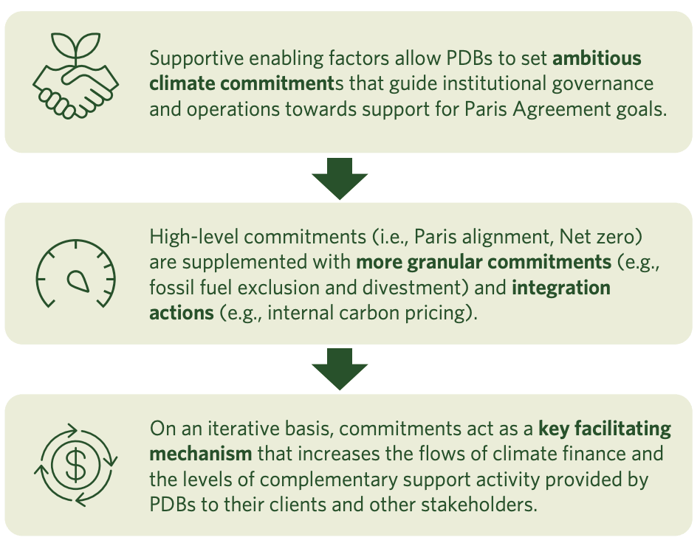Climate ambition among tracked PDBs is plateauing, even though less than half of tracked institutions (70 of 170) have pledged to fully align operations with the Paris Agreement.


Photo credit: Sergey Pesterev
Climate Policy Initiative (CPI) tracks the climate ambitions of public development banks globally, covering 170 institutions that hold more than USD 21,8 trillion in assets, representing more than 95 % of global public development banks assets.
The rate of new climate commitments made by PDBs appears to be declining at a juncture where rapid scaling of PDB climate finance support is crucial. (CPI, 2024).
Global climate finance flows must increase sixfold against 2022 tracked levels by 2030 to meet the average estimates of global climate finance needs (CPI, 2024).
The most recent report published by CPI refers to the need to provide a solid framework for public development banks to achieve ambitious climate goals:

The report also highlights the required sixfold increase of global climate finance flows based on 2022 tracked levels until 2030 to meet of global climate finance needs.
CPI also summarizes the following conclusions and recommendations:
Conclusion 1: PDB climate ambition has plateaued in recent years, with the adoption of climate commitments increasingly polarized between those banks that set ambitions early and others that have consistently demonstrated limited action.Recommendation 1a: Ongoing discussions on international financial architecture reform should focus on raising PDBs’ Paris alignment capacity with consideration of the entire public banking ecosystem and take measures to lift less ambitious institutions to the level of leading institutions.
Recommendation 1b: Accordingly, PDBs with high levels of climate ambition should aim to scale up ongoing initiatives to transparently disseminate methodological guidance and best practices for the implementation of climate commitments by utilizing multi-institutional networks to accelerate adoption by less ambitious institutions through convening and active facilitation.
Conclusion 2: PDBs’ climate commitment levels correspond closely to their intersecting policy and investment contexts, along with their level of participation in multi-institutional networks.
Recommendation 2a: Given the long-term structural change required to shift complex policy and investment environments, multi-institutional networks (e.g., IDFC, Mainstreaming Initiative, FiCS) will need to be properly resourced and scaled to play a leading role in systematically raising PDBs’ climate ambition by strategically leveraging network convening power and shared capacity.
Recommendation 2b: Specifically, multi-institutional networks should seek engagement with non-member and inactive PDBs that have minimal climate commitments but operate in policy and investment contexts similar to more ambitious peers, with the aim of facilitating the adoption of more robust targets and implementation actions among these institutions.
Recommendation 2c: Large high-ambition PDBs, namely multilateral development banks (MDBs) and DFIs, should look to climate financing partnerships (i.e., on-lending or coinvestment) with limited- and minimal-ambition NDBs and SNDBs as opportunities to advance their own commitments not only in terms of financial mobilization but also by supporting the maturation of country-specific platforms for low-emissions climate-resilient development and deepening connections to local stakeholders.
Conclusion 3: PDBs’ successful implementation of climate commitments follows a structured multi-stage process, leading to an iterative re-evaluation of the progress they have achieved against targets, along with ongoing consideration of how commitments are integrated into PDB operating models.
Recommendation 3a: PDBs should frame climate commitments around indicators and benchmarks that can be achieved iteratively and raised incrementally, with the aim of supporting low-emission climate-resilient development.
Recommendation 3b: After initial commitments are achieved, it is imperative that PDBs assess their integration approaches and strength of climate ambition to identify potential areas for improvement, particularly in light of evolving physical and economic contexts and changes to institutional capacity.
For more details refer to the full report.
Published by
 investESG
investESG
 investESG
investESG

